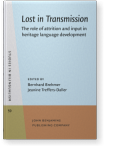David Giancaspro
List of John Benjamins publications for which David Giancaspro plays a role.
2020 The roles of L1 Spanish versus L2 Spanish in L3 Portuguese morphosyntactic development Linguistic Approaches to Portuguese as an Additional Language, Molsing, Karina Veronica, Cristina Becker Lopes Perna and Ana Maria Tramunt Ibaños (eds.), pp. 11–33 | Chapter
This study explores the rate of L3 development among learners that transfer their L1 versus L2, via examination of differential object marking (DOM) by English/Spanish bilingual learners of L3 Brazilian Portuguese (BP). At the L3 initial stages, L1 English/L2 Spanish and L1 Spanish/L1 English… read more
2020 Not in the mood: Frequency effects in heritage speakers’ subjunctive knowledge Lost in Transmission: The role of attrition and input in heritage language development, Brehmer, Bernhard and Jeanine Treffers-Daller (eds.), pp. 71–98 | Chapter
Previous studies (e.g., van Osch & Sleeman 2016; Perez-Cortes 2016) have found that heritage speakers (HSs) of Spanish produce less lexically-selected subjunctive mood morphology than Spanish-dominant speakers. It remains unclear, however, whether the HSs’ tendency to produce less subjunctive mood… read more
2016 Not just algunos, but indeed unos L2ers can acquire scalar implicatures in L2 Spanish Language Acquisition Beyond Parameters: Studies in honour of Juana M. Liceras, Alba de la Fuente, Anahí, Elena Valenzuela and Cristina Martínez Sanz (eds.), pp. 125–145 | Article
This study examines interpretation of scalar implicatures (SI) in the L2 Spanish of native English advanced learners. Spanish is especially interesting since, unlike English, it has two indefinite determiners, unos and algunos, which ostensibly map to English some. However, each does not allow an… read more
2015
While early code-switching research (i.e., Poplack, 1980) focused on the possibility of universal constraints on switching, MacSwan’s (2010, 2014) “Constraint-Free” research program centers on the notion that code-switching is only constrained by the interaction of a bilingual’s two grammars. In… read more
2014 On the structural basis of non-redundant acquisition: Evidence from Spanish bilingual L3 Portuguese Portuguese-Spanish Interfaces: Diachrony, synchrony, and contact, Amaral, Patrícia and Ana Maria Carvalho (eds.), pp. 317–334 | Article
This chapter has two goals: (a) to discuss the Spanish-Portuguese interface in current formal language acquisition research and (b) to highlight the contributions of this language pairing in the emerging field of formal third language (L3) acquisition. The authors discuss two L3 acquisition studies… read more




